KTTK ch.5 (WILL BE ON THE TEST)
1/62
There's no tags or description
Looks like no tags are added yet.
Name | Mastery | Learn | Test | Matching | Spaced |
|---|
No study sessions yet.
63 Terms
virus
Infect every type of cell, including bacteria, algae, fungi, protozoa, plants, and animals
Louis Pasteur hypothesized that rabies was caused by a “living thing” smaller than bacteria
• He also proposed the term virus, which is Latin for “poison”
why viruses are referred to as obligate intracellular parasites.
Cannot multiply unless they invade a specific host cell and instruct its genetic and metabolic machinery to make and release new viruses
describe the basic properties of viruses
• Are obligate intracellular parasites of bacteria, protozoa, fungi, algae, plants, and animals
• Estimated virus particles on earth, approximately 10 times the number of bacteria and archaea combined
• Are ubiquitous in nature and have had major impact on development of biological life
• Are ultramicroscopic in size, ranging from 20 nm up to 1,000 nm (diameter)
• Are not cells; structure is very compact and economical
• Do not independently fulfill the characteristics of life
• Basic structure consists of protein shell (capsid) surrounding nucleic acid core
more properties of viruses
• Nucleic acid can be either DNA or RNA, but not both
• Nucleic acids can be double-stranded DNA, single- stranded DNA, single-stranded RNA, or double-stranded RNA
• Molecules on virus surfaces give them high specificity for attachment to host cell
• Multiply by taking control of host cell’s genetic material and regulating the synthesis and assembly of new viruses
• Lack enzymes for most metabolic processes
• Lack machinery for synthesizing proteins
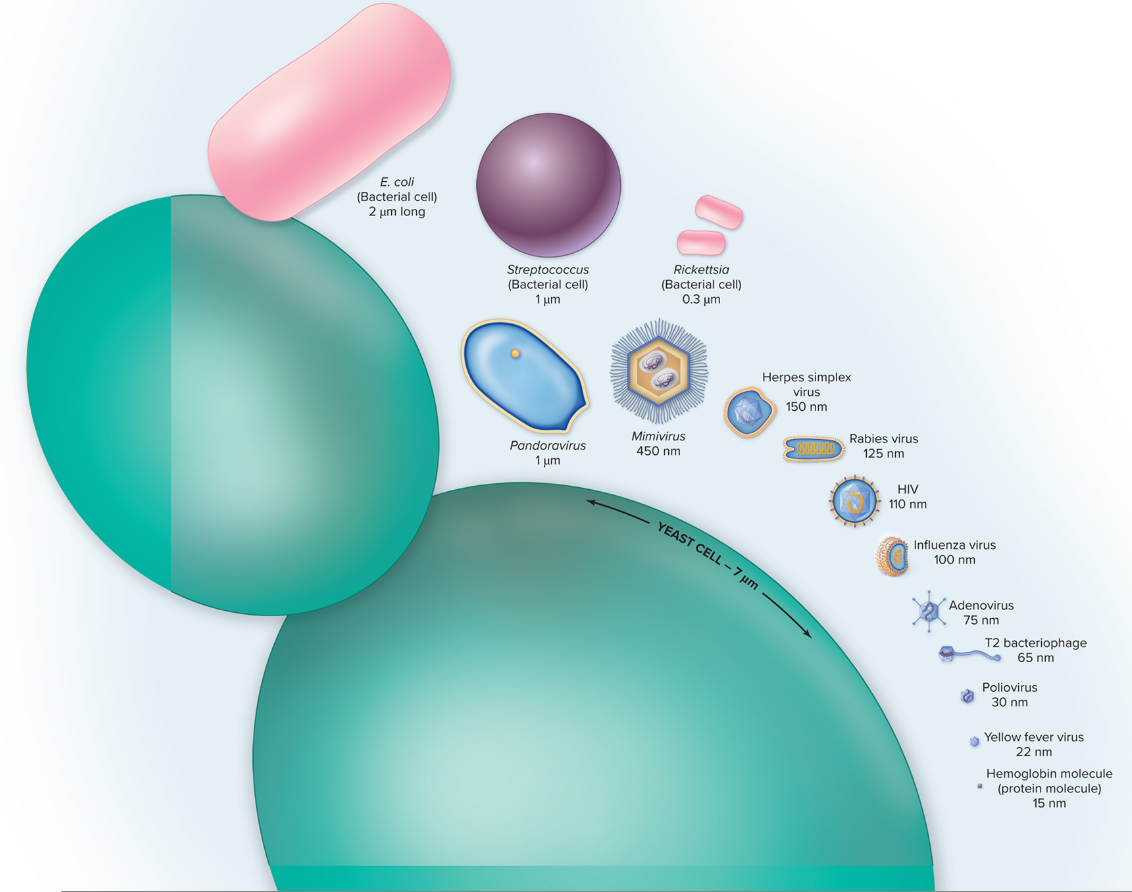
Be able to explain how viruses compare in size to bacteria and
eukaryotic organisms.
1. Smallest infectious agents
2. Smallest viruses: parvoviruses around 20 nm in diameter
3. Largest viruses: herpes simplex virus around 150 nm in length
4. Some cylindrical viruses can be relatively long (800 nm) but are so narrow in diameter (15 nm) that their visibility is limited without an electron microscope
5. Pandoravirus is relatively huge, similar in size to a bacterial cocci
basic viral components
Viruses bear no resemblance to cells and lack any of the protein-synthesizing machinery found in cells
Viral structure is composed of regular, repeating subunits that give rise to their crystalline appearance
The structure contains only those parts needed to invade and control a host cell:
• External shell (capsid)
• Core containing one or more nucleic acid strains of DNA or RNA
• Sometimes one or two enzymes
capsid
protein shell that surrounds the nucleic acid
Nucleocapsid
the capsid together with the nucleic acid
naked viruses
consist only of a nucleocapsid.
envelope
covering external to the capsid, usually a modified piece of the host’s cell membrane
spikes
can be found on naked or enveloped viruses:
• Project from the nucleocapsid or the envelope
• Allow viruses to dock with host cells
virion
a fully formed virus that is able to establish an infection in a host cell
capsomeres
Constructed from identical protein subunits
helical capsid structure
The simpler helical capsids have rod-shaped capsomeres that bond together to form a series of hollow cylinders resembling a bracelet. During the formation of the nucleocapsid, these cylinders link with other cylinders to form a continuous helix into which the nucleic acid strand is coiled.

naked (from helical capsid structure)
The nucleocapsids of naked helical viruses are very rigid and tightly wound into a cylinder-shaped package. An example is the tobacco mosaic virus, which attacks tobacco leaves.
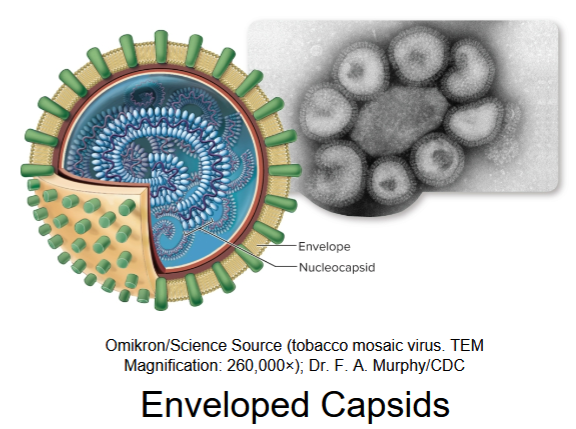
enveloped (from helical capsid structure)
Enveloped helical nucleocapsids are more flexible and tend to be arranged as a looser helix within the envelope. This type of morphology is found in several
enveloped human viruses, including influenza, measles, SARS-CoV-2, and rabies.
icosahedral capsid structure
These capsids form an icosahedron; a three-dimensional, 20-sided figure with 12 evenly spaced corners. The arrangements of the capsomeres vary from one virus to another. Some viruses construct the capsid from a single type of capsomere, while others may contain several types of capsomeres. There are major variations in the number of capsomeres; for example, a poliovirus has 32, and an adenovirus has 252 capsomeres.
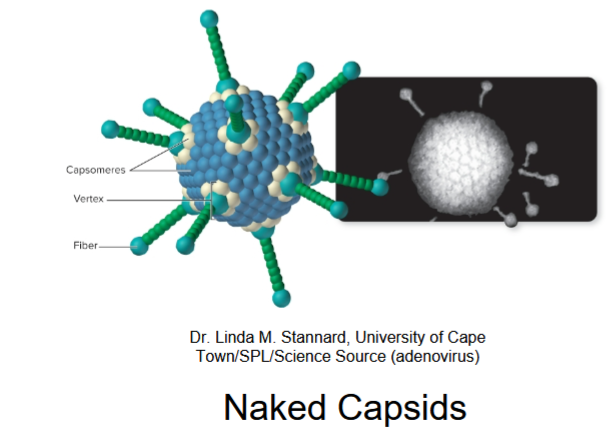
naked (from Icosahedral capsid structure)
Adenovirus is an example of a naked icosahedral virus. In the electron micrograph you can clearly see the spikes, some of which have broken off.
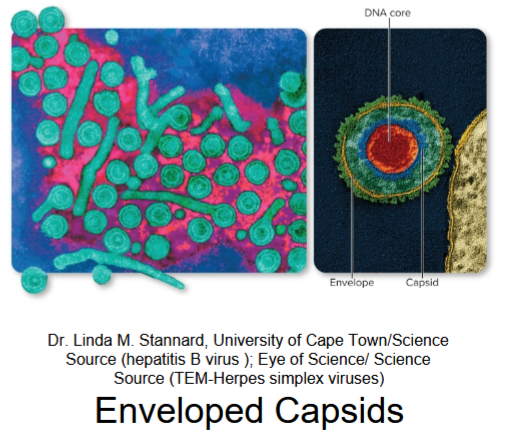
enveloped (icosahedral capsid structure)
Two very common viruses, hepatitis B virus (left) and the herpes simplex virus (right), possess enveloped icosahedrons.
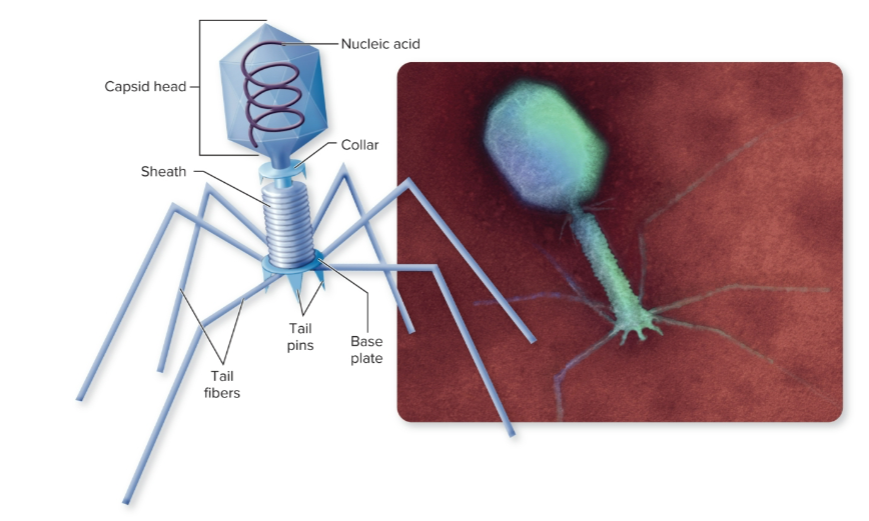
complex capsid structure
Complex capsids, only found in the viruses that infect bacteria, may have multiple types of proteins and take shapes that are not symmetrical. They are never enveloped. The one pictured on the right is a T4 bacteriophage.
Know what the term enveloped virus refers to and where the
enveloped viruses can come from and why they tend to be
pleomorphic
• A piece of the host cell membrane surrounds the capsid during the release process (budding)
• Enveloped viruses can bud from:
• Cell membrane
• Nuclear envelope
• Endoplasmic reticulum
More flexible than the capsid so enveloped viruses are pleomorphic
Know what the genome is and what kind of nucleic acid viruses
contain.
the sum total of the genetic information carried by an organism
Viruses contain DNA or RNA, but not both
Know what the various types of viruses are according to their
nucleic acids
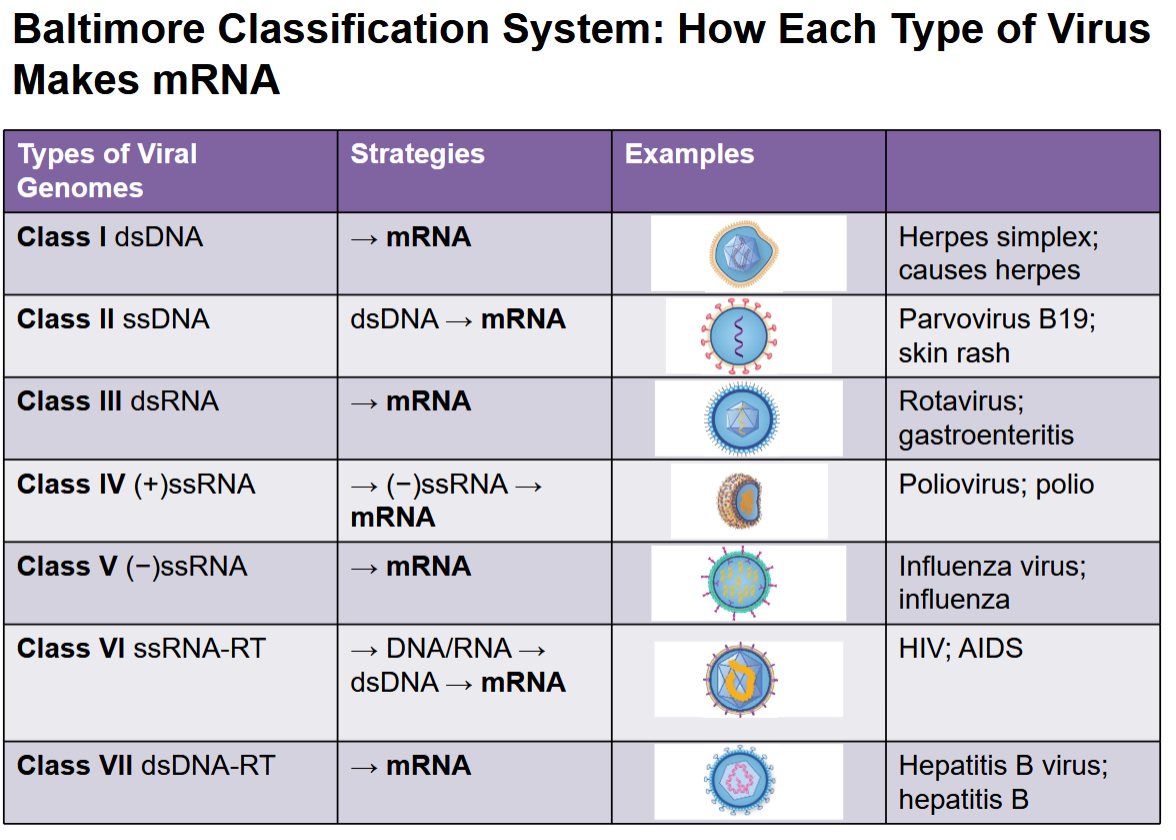
DNA viruses
Single-stranded (ss) or double-stranded (ds; linear or circular)
RNA viruses
can be double-stranded, but more often single-
stranded
Positive-sense RNA
ready for immediate translation
Negative-sense RNA
must be used as a template to make mRNA before translation can occur
Segmented
individual genes exist on separate pieces of RNA
retroviruses
carry their own enzymes to create DNA out of their RNA
Know what the general phases of the animal viral replication cycle
• Adsorption
• Penetration and uncoating
• Synthesis
• Assembly
• Release
The length of the replication cycle varies from 8 hours in polioviruses to 36 hours in herpesviruses
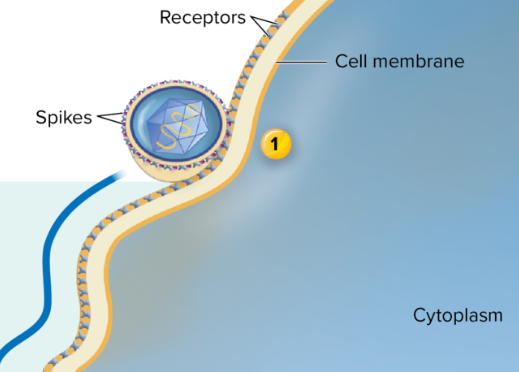
Adsorption
A virus can invade its host cell only through making an exact fit with a specific host molecule
• The virus encounters a susceptible host cell and adsorbs specifically to receptor sites on the cell membrane
• The membrane receptors that viruses attach to are usually proteins that the cell requires for its normal function
• Glycoprotein spikes on the envelope (or on the capsid of naked viruses) bind to the cell membrane receptors
Host range: the range of cells that a virus can infect:
• Hepatitis B (restricted): only the liver cells of humans
• Poliovirus (moderate): intestinal and nerve cells of primates
• Rabies (broad): various cells of all mammals
Cells that lack compatible virus receptors are resistant to adsorption and invasion by that virus
Tropisms: specificities of viruses for certain tissues
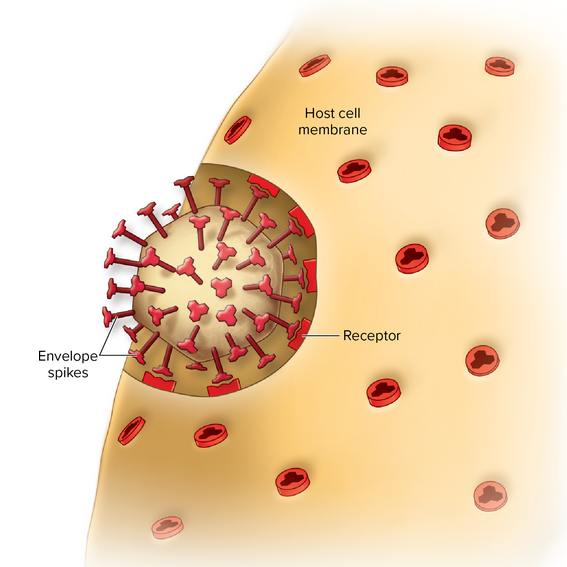

penetration and uncoating
The flexible cell membrane of the host is penetrated by the whole virus or its nucleic acid
• Penetration through endocytosis happens when an entire virus is engulfed by the cell and enclosed in a vacuole or vesicle
• Enzymes within the vacuole may break down the capsid to ‘uncoat’ the virus, freeing the nucleic acid
• Entry can happen through direct fusion of the viral envelope with the host cell membrane
• Envelope merges directly with the cell membrane, liberating the nucleocapsid into the cell’s interior

Be able to explain the two principle means by which animal viruses
penetrate their host cells
(a) herpes viruses: specific attachment and engulfment occur. The virus enters the vesicle. Vesicle, envelope, and capsid break down; uncoating of nucleic acid occurs, and free DNA is released.
(b): mumps virus: specific attachment produces the receptor spike complex. Membrane fusion occurs with the receptors. The nucleocapsid enters the cell. Uncoating of nucleic acid occurs, and free DNA is released

Synthesis: Replication and Protein Production
Viral nucleic acid is used to synthesize the building blocks for new viruses
In the case of a +ssRNA virus:
• The + ssRNA, which is ready to serve as mRNA, starts being translated into viral proteins, especially those useful for further viral replication
• The + strand is then replicated into −ssRNA becoming the template for the creation of many new + ssRNAs, used as the viral genomes for new viruses
• Additional + ssRNAs are synthesized and used for late-stage mRNAs
• Some viruses come equipped with the necessary enzymes for synthesis of viral components; others utilize those of the host
• Proteins for the capsid, spikes, and viral enzymes are synthesized on the host’s ribosomes using its amino acids
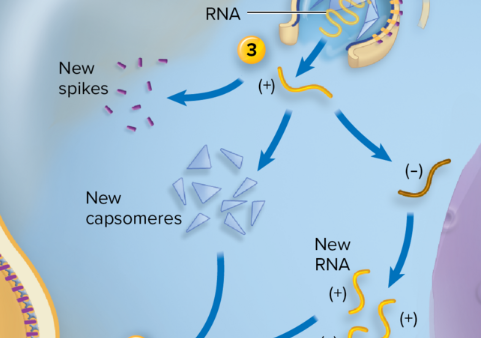
Synthesis: Replication and Protein Production (cont.)
In the case of a DNA virus, the process is in 2 stages:
Early phase:
• Viral DNA enters the nucleus, where genes are transcribed into a messenger RNA
• RNA transcript moves into the cytoplasm to be translated into viral proteins (enzymes) needed to replicate the viral DNA
• The host cell’s DNA polymerase is involved in this phase
Late phase:
• Parts of the viral genome are transcribed and translated into proteins required to form the capsid and other structures
• New viral genomes and capsids are assembled
• Mature viruses are released by budding or cell disintegration
Assembly
• Mature virus particles are constructed from the growing pool of parts
• Capsid is first laid down as an empty shell that will serve as a receptacle for the nucleic acid strand
• Viral spikes are inserted into the host’s cell membrane so they can be picked up as the virus buds off with its envelope
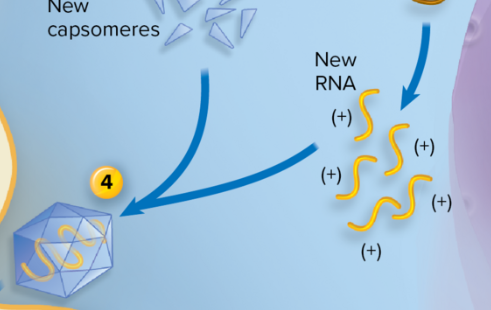
(release)
nonenveloped and complex viruses are released from the host cell
Nonenveloped and complex viruses that reach maturation in the cell nucleus or cytoplasm are released when the cell lyses or ruptures
(release)
envelopes viruses are liberated
Enveloped viruses are liberated by budding from the membranes of the cytoplasm, nucleus, endoplasmic reticulum, or vesicles

release
• During this process, the nucleocapsid binds to the membrane, which curves completely around it and forms a small pouch
• Pinching off the pouch releases the virus with its envelope
The number of viruses released by infected cells is variable, controlled by:
• Size of the virus
• Health of the host cell
A poxvirus-infected cell may release 3,000 to 4,000 virions
A poliovirus-infected cell may release up to 100,000 virions
With these large numbers, there is immense potential for rapid viral proliferation as they encounter susceptible cells
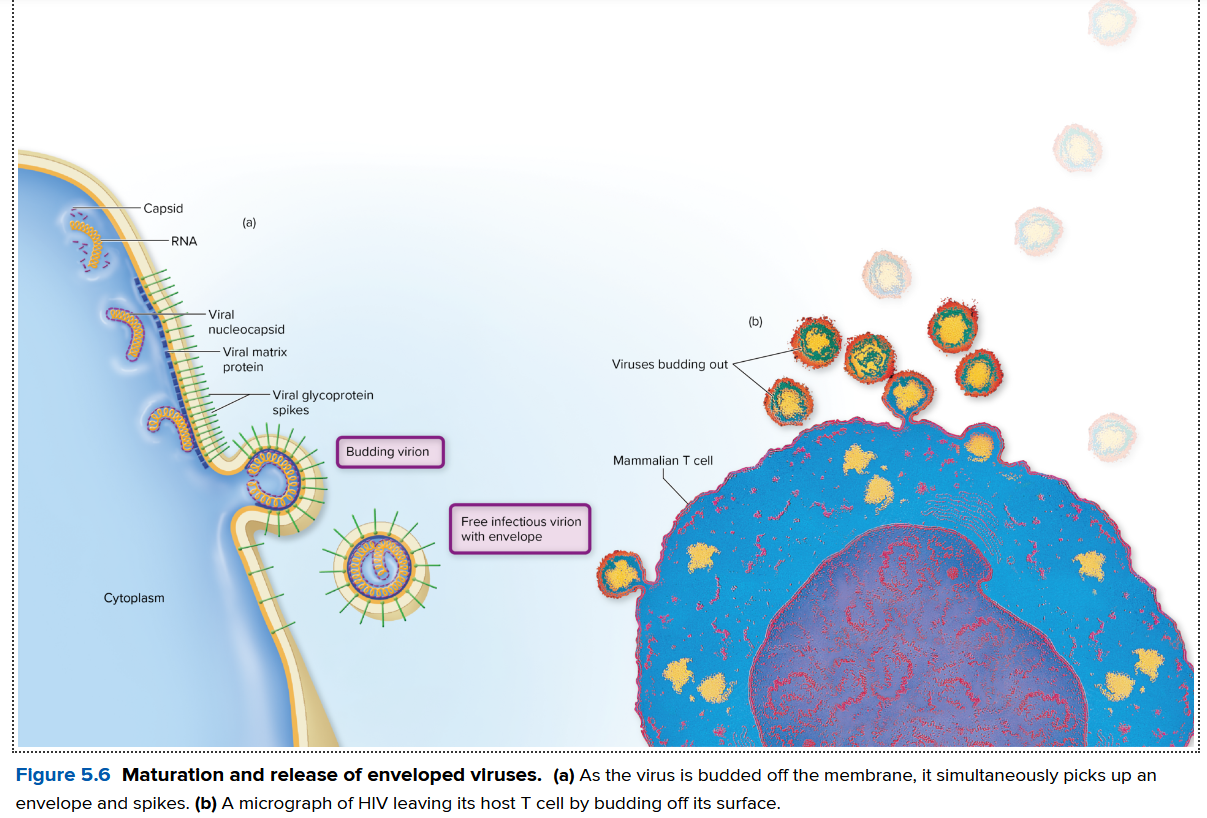
Cytopathic effects (CPEs)
virus-induced damage to the cell alters its microscopic appearance
Types of CPEs include:
• Gross changes in shape and size
• Development of intracellular changes
inclusion bodies
compacted masses of viruses or damaged cell organelles in the nucleus and cytoplasm
syncytia
fusion of multiple damaged host cells into single large cells containing multiple nuclei (giant cells)
persistent infections
Some cells maintain a carrier relationship: the cell harbors the virus and is not immediately lysed:
• Can last from a few weeks to the remainder of the host’s life
• Can remain latent in the cytoplasm
provirus
• Viral DNA becomes incorporated into the DNA of the host
• The measles virus behaves this way in brain cells, occasionally causing progressive damage
chronic latent state
• Latent viruses periodically become activated under the influence of various stimuli
• Herpes simplex (herpes) and herpes zoster viruses (chickenpox and shingles) behave this way
oncoviruses
Experts estimate that 20% of cancers are caused
transformation
the effect of oncogenic, or cancer-causing viruses on host cells:
• Some viruses carry genes that directly cause cancer
• Other viruses produce proteins that induce a loss of growth regulation, leading to cancer
Know what a virus that infects bacteria is called.
Bacteriophage: “bacteria eating”
virophage
Another type of virus was recently discovered.
since they parasitize other, larger viruses that are themselves within a host cell
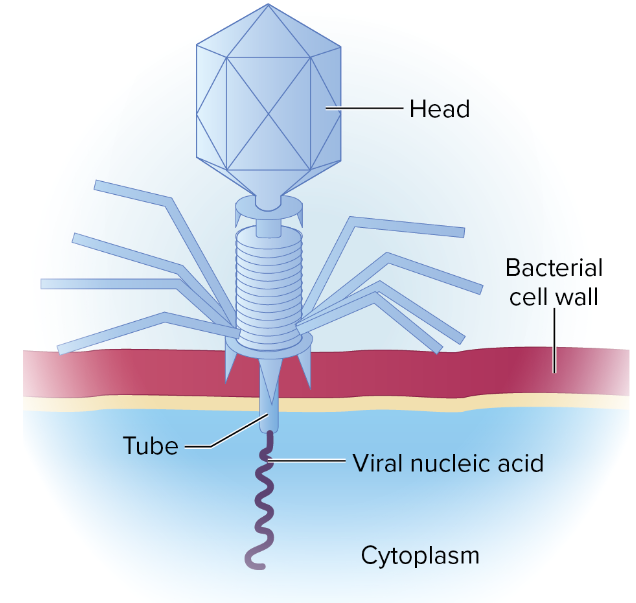
Be able to describe the structure of a T-even bacteriophage
Infect E. coli
Structure:
• Icosahedral capsid containing DNA
• Central tube surrounded by a sheath
• Collar
• Base plate
• Tail pins
• Fibers
lysogeny
The silent virus infection
a condition in which the host chromosome carries bacteriophage DNA
Temperate phages
Undergo adsorption and penetration
• Do not undergo replication or release immediately
prophage state
Viral DNA enters an inactive prophage state:
• Inserted into bacterial chromosome
• Copied during normal bacterial cell division
induction
prophage in a lysogenic cell becomes activated and progresses directly
into viral replication and the lytic cycle
lysogenic conversion
when a bacterium acquires a new trait from its temperate phage:
• Corynebacterium diphtheriae - diphtheria toxin
• Vibrio cholerae - cholera toxin
• Clostridium botulinum - botulinum toxins
techniques in cultivating:
in vivo
laboratory-bred animals and embryonic bird tissues
techniques in cultivating:
in vitro
cell or tissue culture methods
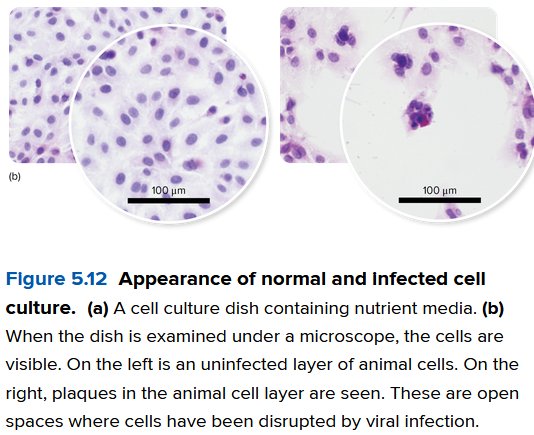
Be able to explain what plaques are and why you would look for them in cell culture
areas where virus-infected cells have been destroyed
• Show up as clear, well-defined patches in the cell sheet of tissue culture
• Plaques are a visible manifestation of cytopathic effects (CPEs)
name three noncellular infectious agents besides viruses.
prions
satellite viruses
viroids
prion is and the diseases it can cause.
Composed primarily of protein (no nucleic acid)
Exact mode of infection is still being investigated
Deposited as long protein fibrils in the brain tissue of humans and animals:
• Creutzfeldt-Jakob disease afflicts the central nervous system and causes degeneration and death, acquired one of three ways:
• Genetic mutation
• Sporadic CJD
• Acquired CJD (medical instruments, organ transplants, consuming infected
meat)
• In bovine spongiform encephalopathy (BSE “mad cow disease”) the prions can be transmitted to humans
Proteinaceous infectious particles
Inherited and transmissible by ingestion, transplant, and surgical instruments
• Spongiform encephalopathies
• “Mad cow disease”
• Creutzfeldt-Jakob disease (C J D)
• Gerstmann-Sträussler-Scheinker syndrome
• Fatal familial insomnia
• Sheep scrapie
• Chronic wasting disease of deer, elk, and moose
satellite virus
Dependent on other viruses for replication Adeno-associated virus (AAV):
• Originally thought that it could only replicate in cells infected with the adenovirus
• Can also infect cells that are infected with other viruses Delta agent:
• Naked circle of RNA
• Expressed only in the presence of the hepatitis B virus
• Worsens the severity of liver damage
describe viroids and what type of organisms they
parasitize.
• Virus-like agents that parasitize plants
• About one-tenth the size of an average virus
• Composed of naked strands of RNA, lacking a capsid or any other type of coating
• Significant pathogens in economically important plants: tomatoes, potatoes, cucumbers, citrus trees, chrysanthemums
Know why antibiotics do not work on viral diseases and why it is harder to develop antiviral medications.
Antibiotics designed to treat bacterial infections have no effect on viruses
Difficult to find drugs that will affect viruses without damaging host cells
Almost all antiviral drugs licensed so far have been designed to target one of the steps in the viral life cycle:
• For example, the integrase inhibitor class of HIV drugs interrupts the ability of HIV genetic information to incorporate into the host cell DNA
• Paxlovid for COVID-19 inhibits a packaging enzyme